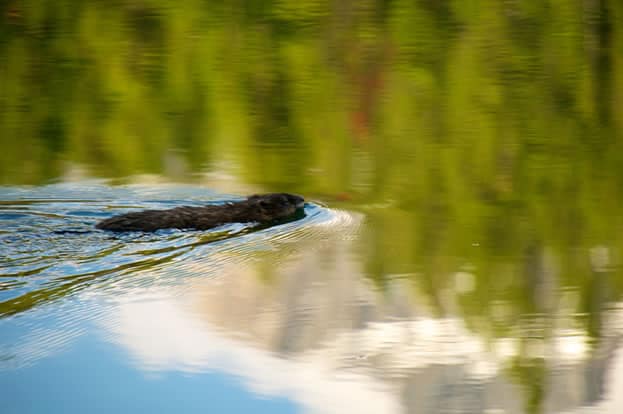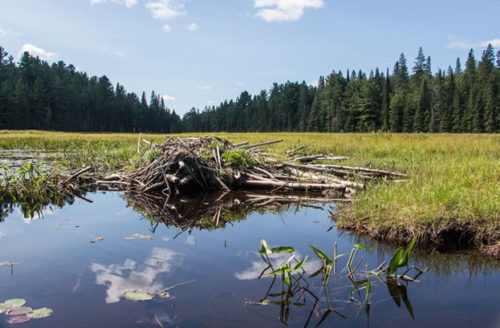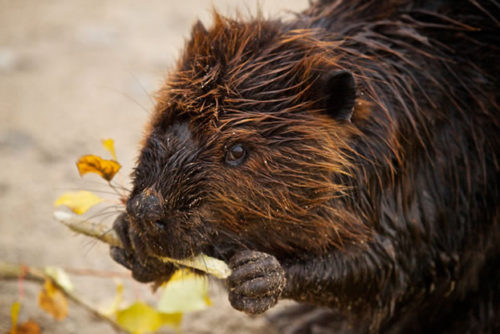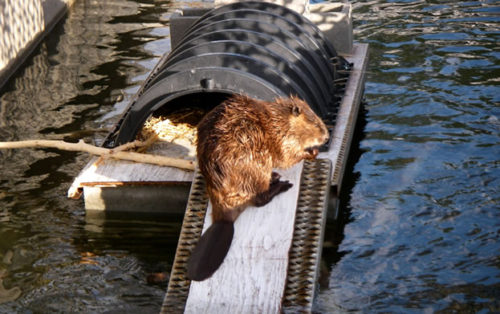
Better with Beavers: How partnerships with a rodent are helping restore watersheds in the Pacific Northwest
“In the beginning, there was nothing but water and ice and a narrow strip of shoreline,” says the oral tradition of the Nuxalk, the coastal people who have lived for millennia near present-day Bella Coola, British Columbia. As the last ice age waned 12,000 years ago, their ancestors found home in that fertile rim of land and sea. And as temperatures rose, the once-frozen land must have churned in a vast soupy spillage, learning with ice-melt the forms we now call river, stream, pond. In this great thaw, when the earth emerged soaked and naked and surging to green, I trust a beaver knew what to do. I trust beavers were there, and also farther south in present-day Whatcom County, Washington, where I live. Before the county – and the creek, town, and lake – took the Whatcom name, I trust beavers were near the creek mouth and fish camp the Nooksack people dubbed Xwótqwem after the sound of water dripping, fast and hard.
To beavers, this sound is a calling. Their DNA is strung taut with fix-it genes, and if the creek’s slope is low and trees are near, the water’s flow will be thwarted. Though nourished by the thin cambium layer of sugary cells beneath the trees’ bark, beavers use the bulk of their fellings to serve this damming instinct. The apparent goal – pursued with unyielding intuition and speed – is to expand aquatic habitat, which to a beaver means safety and access to food. Ecologist Alexander Badyaev has shown how beavers fell over 70 percent of their trees towards water, where the real tasks then begin: branch-clipping, thatching, stone-rolling, mud-splotching, flow-lock latticing, wattle-and-daubing.
Beavers seem to know that healthy waters need wood – big wood to scour deep pools, dead wood to fertilize them, racked-up wood to complicate the flow. The intricacies of their dams, lodges, and mazing canals surpass all belief, in spite of – or rather, because of – the ways they are riven with a wild porosity, in need of constant maintenance. With all this industry and adaptive efficacy, beavers are deserving “ecosystem engineers,” even as they compel more expansive definitions for this very term. We typically engineer ecosystems by neatening and bleakening them with inert structures, often at the expense of other species. But the organic approach of Castor canadensis actually increases biodiversity, including direct contributions to over 25 percent of herbaceous plant species along forested rivers and streams.
In this respect, beavers are also “keystone species” that have disproportionately large impacts on their neighbors, including us. Suffice it to say that paradigms exploded when archaeologists began to discover petrified woodcuttings bearing the marks of teeth, not human tools. Only then could they accept how our early ancestors thrived with the firewood, game, water, and safety they found in the beavers’ habitat. Long before the first human was born, several ancient beavers had gone extinct – including the woodchuck-sized species that tunneled corkscrews underground, and the bear-sized ones that never built dams. But just before our own evolution began, beavers perfected their semi-aquatic, tree-cutting niche. Two seven-million-year-old teeth near the John Day Fossil Beds of Oregon comprise our continent’s oldest record of the North American beaver, a species that likely traversed the Bering Land Bridge.
The discerning eye can look at maps of the Pacific Northwest and pick out lands where beavers came before. Some remain fertile wetlands, others are now pastures with “good” groundwater, still more are wet floral meadows tucked away in the woods. Our most livable and lovable landscapes are often ancient beaver ponds, first cleared, composted, and irrigated by beavers long ago. For the many happy bovines we see amid the longest-green grass, we can thank a beaver. For the homes that are flood-buffered or firewise with nearby ponds, we also can thank a beaver. And if you drink water in Bellingham, Washington, it’s been stored and filtered by wetlands upstream. At least for this, we can surely thank a beaver.
Most of us have trouble reading these beavered landscapes today. We are now inexperienced and forgetful, marred and mistaken by the fur trade’s near erasure of this species. For nearly three-hundred years, when beaver-killing was but a tool of nation-building, the fur trade plunged nationwide beaver populations from more than 60 million animals to a mere 100,000.
Fueled chiefly by a hat fad, but also the insatiable thirst for waterpower and fertile bottomlands, our own forebears desecrated the beavers and their creations. Festering agitations between the fur-hungry British and Americans finally climaxed in the 1820s throughout the contested “Oregon Country,” where firm national boundaries – or respect for them – failed year after year. It was then that George Simpson, British governor of the Hudson’s Bay Company, declared his lamentable “fur desert” policy: a preemptive, scorched-earth assault on the beaver, operating on the assumption that “If the country becomes exhausted in Fur [sic] bearing animals [the Americans] can have no inducement to proceed hither.” Politically, Simpson’s plan became just another botched campaign, and the Americans did proceed thither. Ecologically, the cost was incalculable.
Fur gradually fell out of fashion, and the survivors are now reasserting their presence, quietly resuming the night shift in their ancient restorations. As nationwide beaver populations reach over 10 million again, we are being given a second chance to tolerate – and even cooperate with – these mysterious animals.
This renewed quest for coexistence began as early as 1904, when concerned sportsmen made the nation’s first beaver reintroduction in upstate New York’s Adirondack Mountains. Ironically enough, they purchased 7 of the 20 beavers from the Canadian exhibit of the Louisiana Purchase Exposition in St. Louis, a centennial celebration of the Jeffersonian dream that paved the fur traders’ paths.
By that time, trees and salmon had replaced the beaver as the most-wanted “resources” in the Pacific Northwest. Our bottomless hungers would continue to drive many a losing battle against nature and for nature, but now, at least in some places, we are trying to change old patterns. The way forward, it seems, is to fight together with nature. This restoration economy, which often allies the public and private sectors at the watershed scale, is putting people to work in places where resource extraction has compromised shared goals like clean air and water, or healthy wildlife habitat. Salmon have been – and still are – the leading mascots of this regenerative work, integral as they are to the ecology and culture in every inch of this region. We have thrown millions of dollars towards labor intensive projects, including mechanical additions of “large woody debris” and “engineered log jams” (dubbed “LWD” and “ELJ” in restoration jargon) to restore river complexity, and thereby stability and diversity.
Most of my twenties have been spent serving this vision, and in doing so I’ve felt my own homing; I’ve felt a part of something like one salmon in a mighty, thronging school. I’m sure thousands of people have likewise been changed by the salmon’s need for wooded waters, and whether we read about it through increasingly eco-savvy news, or experience the hands-on toils of streamside invasive species management, we have done a great deal to better this region for fish and for us.
Yet as trials and errors teach us time and again that no one person can achieve restoration alone, the promise of partnership has taken a new turn. The return of beavers to their former haunts is showing us that even our species – the great Homo sapiens – can’t achieve restoration alone. While the Pacific Northwest remains collectively committed to the ongoing work of restoration, there is the growing awareness that our former salmon abundance was made possible with the beavers’ work. The last five centuries aside, beavers were one of the greatest earth-shapers on the continent, creating the very conditions in which our beloved salmon evolved. However much it jabs at our hubris, we are realizing that our aspirations to restore landscapes may be a kind of beaver mimicry. ELJs are, after all, what beavers do. Near my home, in the Stillaguamish River watershed, the National Oceanic and Atmospheric Administration even estimates that, after the fur trade, winter habitats producing young salmon were reduced by 86 percent without the beavers’ presence.
It’s no wonder that beaver-based restoration partnerships are forming all around the region, eager to dispatch the rodents like mercenaries to the frontlines of damaged watersheds. And where direct reintroductions are not possible or practical, we are learning to welcome the rodents who naturally return.

A beaver lodge surrounded by water. Beavers’ unique approach to ecosystem engineering increases biodiversity along forested rivers and streams. Photo by Ahmed Sagarwala
Like most big, necessary recoveries, the steps toward beaver restoration exist on a spectrum of intervention, but each in its own way calls for a level of adaptive, place-based management. We have gotten to the moon and achieved many a fixed goal, but beaver restoration is teaching us to manage for unmanageable resiliencies that keep the earth alive. In the face of climate change – and all other planetary uncertainties it portends – beavers convey one of the great lessons of permaculture: that we are nature, working.
One of the earliest regional precedents for reintroduction came in the 1930s, when the federal government moved 600 beavers upstream of Civilian Conservation Corps crews aiming to thwart erosion in arid wheat fields around Spokane, Washington. By 1948, Idaho one-upped the federal initiative with a state-sponsored plan to parachute beavers to eroded mountain headwaters. Incredulous as it seems today, it was common sense to those who dealt with “nuisance” beavers in the expanding farmlands around the post-World War II town of McCall.
Idaho Fish & Game biologist Elmo W. Heter was thoughtful enough to move them in summer, so they could have enough time for winter preparations. He knew that lack of water, along with heat and sun, would overwhelm the beavers on their long journey into the Frank Church-River of No Return Wilderness, where Heter’s crew thought they would remain far from human settlements and could improve watershed health. Moving them with the help of beasts of burden was not possible, because, as he wrote in his report for the Journal of Wildlife Management, the “horses and mules become spooky and quarrelsome when loaded with a struggling, odorous pair of live beavers.” So flight it was, the beavers drifting down from 500 to 800 feet in specially invented willow boxes, ventilated, interlocking, and “fitted together to open as a suitcase does.” A total of 76 beavers were dropped that year (with only one casualty), a success rate presaged through Heter’s many trials with the world’s first beaver paratrooper – the relentless old male called Geronimo. That these labors surprise us today should tell us something about where our imaginations could be. The work of beaver restoration comes in many forms, and clearly, for some, the sky is the limit.
One of the greatest lessons that Geronimo and his fellow paratroopers taught us is that our watershed headwaters are the places where we can help beavers help us make the biggest impact. In addition to reducing lowland annoyances to farmers, a TIME magazine article touted the beavers replenishing of the water supply near Salmon, Idaho, “saving the city the cost of a dam.” In his report, Heter was also quick to give a Thoreau-like accounting for the boxes, cargo chutes, and flying time, which totaled a mere $30. And seeing his transplants succeed the following year, he knew the return on investment would keep coming, seen downstream in water that flowed cleanly, consistently.
On the east side of Whatcom County, across the North Cascades, my neighbors in the Methow Valley, Washington have also seen beaver relocations as an economic and ecological boon. They have been helped by the state’s “Beaver Bill” (HB 2349), passed in 2012 to upgrade our state’s lamentable beaver management policies (or lack thereof). In the past, it has always been easiest to call up the nearest “Wildlife Control Operator” for a hasty (i.e., lethal) dispatch of a “nuisance” animal. But the Beaver Bill reduced the red tape that slowed non-lethal options, and gave the Washington Department of Fish and Wildlife full authority to relocate unwanted beavers to appropriate public lands, or the property of willing landowners. Where it had once been no more than a beaver exterminator, called in for the dirty work, the department could now be an employment agency, keeping beavers working in the right place at the right time.
Given that the last couple years had been some of the driest and fieriest the Methow Valley has ever seen, the region was ripe for this upgrade. Locals had already started working on the effort prior to the bill’s passage, founding the Methow Beaver Project – a partnership of the US Forest Service, Washington Department of Fish and Wildlife, and the Methow Salmon Recovery Foundation – on the belief that beavers are the best hope to stave off these effects of climate change. Beavers may indeed be the only true counter to decreasingly reliable mountain snowpack, for their labors are adaptable enough to spread, sink, and slow the precious water flow by restoring wood and river complexity.

As their populations reach over 10 million, we are given a second chance to tolerate, and cooperate, with beavers. Photo by Benjamin Jakabek Photography
US Forest Service biologist Kent Woodruff knows that many landowners consider beavers problematic, but his leadership on the project has shown them how these animals can aid us in timely, cost-effective ways. Woodruff can talk about beavers one minute as though they are venerable elders; in another, they might be an Allen wrench, just the right size; in the next, he might be on his knees, pointing out to some visiting schoolkid what makes one beaver’s tail unlike all the others. It’s no wonder that Woodruff has been dubbed a “beaver whisperer.” Since 2008, the project has relocated over 300 beavers around the Methow Valley watershed, most to headwater streams on public land.
While it does not fly beavers into the hinterlands, my visit with Woodruff to project headquarters – the Winthrop National Fish Hatchery – and several release sites affirmed that careful preparations make it an equally valid success. Of course, their approach strives to avoid all mortality, but it also goes beyond the traditional NIMBY quick-fixes that make for problems elsewhere. Their release sites are carefully selected to maximize food richness and watershed productivity, often with some freshly hewn aspens and cottonwoods boughs for appetizers and a makeshift lodge. And because Woodruff’s crew is aware that beavers have such vital family dependencies, they work to catch all members (which can include as many as three generations) before releasing them together. Until the entire family is corralled, the caught wait, protected and well fed in surplus tanks at the salmon hatchery. During this short interval, the project scientists sex the beavers, assign microtags, and take measurements, hair samples, and tail pictures for identification in future monitoring. Based on the success of their existing releases, the Methow Beaver Project estimates that each beaver has done at least $1,750 worth of restoration work, and counting.
Glamorous as these intensive restorations are, sometimes the simplest tactic is just to let the beavers come home. But this can also be the most challenging approach – while still the most necessary – because it requires a coexistence that conquers our perceptions of beavers as pests. Reintroductions typically happen because beavers are not wanted at a particular place and are moved somewhere else, but in natural recolonizations beavers choose the place themselves. It happens most often around April, when another set of newborns makes lodge-life too crowded for the two-year-olds. The one-year-olds can stay on to help the adults clean the lodge, care for newborns, and repair the infrastructure, but the two-year-olds’ involvement in this unique “cooperative breeding” arrangement will have come to a close. For beavers, dispersal is a dangerous, lonely gauntlet, full of currents, bears, traps, droughts, cars, coyotes, drainage ditches, sewers, golf courses, mountains, more cars, and treelessness. In fact, low-gradient, well-wooded wetlands are so rare in most places that it’s a downright miracle for a beaver to find productive habitat without rival beavers and with friendly people. And doubly so is the marvel of those who find a worthy mate. At the extreme, such a prize might demand thirty miles and nearly six months, each day of which cuts at the time needed to recreate a watershed before winter.
Thankfully, there are growing numbers of people who welcome these nomads. Over the past two years, I have worked weekly as a land steward with Tricia Otto, a retired doctor and avid conservationist who had long sought to restore native biodiversity on a wounded piece of land. In 1989, when Tricia bought her hundred-acre parcel of weed-sprung woods outside Bellingham, she never thought beavers would enter the scene. But soon after her arrival, the beavers followed. First they clogged an old culvert, which backed up the little-trickle-of-a-blackberry-strangled-creek, which ultimately drowned her driveway. After a few winters of driving through standing water, she realized the beavers were doing other things: As silent teeth sawed through the nights and wet roots went to rot, trees fell. And in the felling, even-aged woods became a multigenerational community. Light hit the land again, and sometimes the land became water. Without even asking, the beavers were helping Tricia achieve her conservation goals.
The flooded driveway was no longer a problem, but a goad for a larger solution. As if to thank the beavers for their pro bono restoration labors, Tricia invested in a $40,000 bridge to replace the driveway. This is beyond what most people can afford, but Tricia knew this crossing was just compensation for the beavers’ work, paid forward by the access it has offered to the hundreds of people she has brought to enjoy and learn from her land. And there are umpteen cheaper ways Tricia welcomes beavers, from hurling wind-fallen cottonwood boughs (a favorite treat) into the swamp so they don’t risk predation in overland travels, to dibbling cuttings of red-osier dogwood (another favorite treat) into the banks. There is no doubt Tricia still upholds the oath of her profession with her ongoing practice of care, affirming that “whatsoever houses I enter, I will enter to help the sick, and I will abstain from all intentional wrong-doing and harm.”

Beavers temporarily held at Winthrop National Fish Hatchery are moved as families or grouped with compatible mates, increasing the likelihood of successful reintroduction. Photo by Chris Pasley/USFWS
Do-no-harm may be the mantra of all who welcome beavers’ natural return to private lands, but the effects are impossible to generalize. Given their water filtration and storage services, it seems downright convenient how they showed up on Tricia’s rural Lake Whatcom tributary. But what does the practice of nonviolence mean when the beavers come to more populated places? Since beavers hole up in darkness for most of the day and require only good flow and wood, urban waters free of predators could make a good home. Indeed, some beavers have made headlines in the greater metropolitan area of Portland, Oregon over the last few years. Yes, Portland – that last sleepy checkpoint of the fur-traders’ journey, less than a hundred miles from their fabled terminus in Astoria.
In the past several decades, Portland, with its progressive urban growth boundary to constrict sprawl and keep the city green, has become a destination of the eco-friendly. And ever since officials from nearby Tigard, Oregon rashly breached a beaver dam, locals have started to speak up for their state animal. Greater Portland’s urban parks have become oases touted for “beaver watching” opportunities, and wherever possible, beavers are allowed to do what beavers do. The sheer curiosity these rodents provoke has shown that our natural aesthetics are wildly adaptable. Where the beavers draw too close for comfort, there are options. People are learning to foil the fellers from taking down cherished trees with hardy fences, or by coating the trunks with an abrasive paint-sand mixture.
And where beavers are truly threatening safety, public infrastructure, or private homes, people are turning to the rapidly evolving realm of non-lethal fences and flow devices aimed at beaver-proofing culverts and stream channels where flooding could be an issue. These relatively inexpensive devices include the Beaver Deceiver – a fence that prevents the beaver from coming too close to a culvert, and the Castor Master – which keeps a pond’s water level from rising above a certain height. These remarkable tools have worked for thousands across the continent, and in Europe, where Eurasian beaver (Castor fiber) numbers are on the rise.
As a kid, I never understood how waterfalls keep water falling, how rivers keep running. Here in Whatcom County, now in my third decade, I’m still not sure. Or perhaps I take our glacial remnants, high in the North Cascades, for granted. But with each passing summer, as fires creep over the Cascade crest, I know more and more clearly: Each drop is precious. Even in winter-wet Whatcom, our drier-than-usual summers demand that we work for, and with, our water. For this place to be habitable for us – and for more than us – we must slow, sink, and spread the flow. And, perhaps most importantly, this water must steep in some forests like the finest of teas, diversified and stabilized with riffles, crannies, shade-spots, and pools.
We can’t restore ecosystems alone. We have great resources out there, like the Beaver Restoration Guidebook, an infinitely practical, inspiring tome of case studies and how-tos from leading practitioners. And yet there is many a night when I put my head down, afraid I have not yet done enough, known enough, or tried enough to steward this place. In such times I take heart in how beavers recall the words of ecologist Frank Egler, who said, “Nature is not only more complex than we think; it is more complex than we can think.” I take heart in the ways we increasingly see our fellow animals not as objects to save, but as allies with common cause. The beaver is a model, measure, and motivation for this work, and I trust that we have much to live for, together. When my workday is done, I trust that somewhere, on a dark and fast-dripping stream, a beaver’s shift begins.
Rob Rich is a naturalist and writer whose work has appeared in Camas, High Country News, and elsewhere.
Originally published in Earth Island Journal, March 2017

